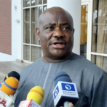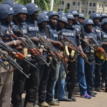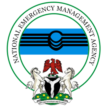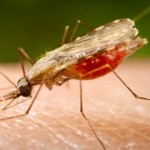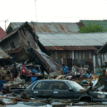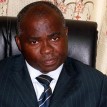The Director-General, National Emergency Management Agency, Mustapha Maihaja, tells IFEANYI ONUBA and OKECHUKWU NNODIM that emergency management agencies in states are the weak links in disaster management
The flood in four states, among the states that are affected, has been declared as a national disaster. Please explain.
READ ALSO: I sacrificed my career for my children –Chuddy K
The 12 states are the frontline states along Rivers Niger and Benue. So, there are 12 frontline states that are really threatened by the rising level of water in the two rivers. But four states are already experiencing the devastating flood as a result of the rise in the water levels at the confluence of the two rivers in Lokoja.
The situation was declared a national disaster or emergency because of the quantum of flood in those four states. Also it means that the states cannot cope with the magnitude of devastation hence the federal government’s response is considered necessary. So declaration of national disaster means that the DG of NEMA, under the delegated authority of Mr. President, can require any federal agency to use its authority and resources to support the states. This is under coordination of NEMA as provided by the Act establishing the agency.
Eight states were put under red alert. What does this mean?
The eight states are being monitored because it is expected that if the water level continues to rise, the states will also experience very serious flooding and this may lead to disaster. So, that is why they are kept under monitoring and we are prepared to ensure that we respond very quickly. However, in the 12 states, we have deployed search and rescue personnel with rescue operations and facilities in place. Evacuation was carried out in some of them so that if the flood comes, the consequences will be reduced to the minimum.
How would you rate the cooperation that you have been getting from the affected states?
The states that we have declared national disaster can only work with us because the Federal Government has taken over the disaster management activities there. We will use the apparatus of the states that are being monitored. I mean their emergency management agencies will work in collaboration with our personnel to ensure that the evacuation from the affected areas is done.
However, the fact is that in the emergency structure, the states remain a weak link in terms of funding and capacity. That is why sometimes, NEMA tends to be overstretched when such kind of emergency happens simultaneously because we, at times, had to do the work of the states.
What are the functions of the Emergency Operation Centres?
Prior to the declaration of national disaster, there were certain policies established by government. First, the National Disaster Response Plan is a policy approved by the Federal Government that guides operations under emergencies. There is the National Contingency Plan which is a policy document that also guides us in setting up formidable structures to respond to disasters and so it was activated on September 15 this year. Then the EOCs had to be created. There is the National EOC located at the headquarters and five other territorial EOCs have been activated. They work 24 hours, receiving information, data and all necessary messages required to guide us in taking certain decisions that are absolutely necessary in addressing this issue. For example, we have a number of people affected and this number can grow further. So the EOCs on the ground in any territory will send information stating that they need food supplies, water and any other thing that should be deployed.
READ ALSO: Despite huge gas reserves, power plants suffer shortages
The flood situation this year is becoming severe. Can it be compared now to what was experienced in 2012?
In reality the flood levels from September 6 to September 22 this year are more than the levels experienced in 2012. But the 2012 disaster occurred when the water level reached 12.84 metres and this happened on September 29, 2012. So expectedly, with the rate at which it is rising now, on September 29 this year it may exceed 12.84m. This means we could reach 12.84m earlier than September 29, but as of September 21, it was 11.21m, just a few metres away from 12.84m.
In 2012, the casualty figure was high. What’s the figure now?
As of September 22, 2018, we’ve recorded over 100 casualties and it was 363 in 2012. We announced 70 casualties in our previous briefings but the casualty figure has risen to 101 on September 22.
Apart from the 12 states identified, is there a likelihood that the situation may spread to other states?
No, because the states that are affected currently are located along the bank of the two rivers. In fact, the rivers pass through these 12 states.
In one of your reports, it was stated that NEMA would need about N12bn to manage the situation but what you have is about N3bn. How do you intend to raise the remaining balance of about N9bn?
This is how it is done professionally. You will consider the number of displaced people, logistics and other requirements that you need to cater for. Now, for the first one month, we need a little above N3bn. This operation will extend up to February or March (2019) and so, when you extrapolate, then you will come up with the requirement for the period that I just mentioned and this amounts to about N12bn. But right now, we are still adequately funded to take care of what we need.
What is the level of cooperation from those people that have been affected by the disaster?
The people are in distress. Imagine now that your phone is lost, how will you react to it? Those people have lost their houses, property and all the assets that they must have bought over the years. So obviously, it’s a situation that is devastating to them and so the people are very worried which is why our task is to ensure that we alleviate their sufferings.
How are responders’ requests on boats and GPS mapping being met?
We have a department on GIS here and there are international agencies such as the United Nations that we are using their facilities. We are also using that of the European Commission and so every facility required is on the ground. The structure is perfectly positioned to really respond to any emergency even beyond what we are facing now.
Are you collaborating with the ministry of agriculture considering that over 60,208 hectares of agric land have been destroyed?
At the first meeting that we convened on September 7, when we observed this situation, when it was growing at an alarming rate, when we declared national disaster, all stakeholders, such as ministries of water resources, environment and agriculture and other stakeholders and agencies of government, came together to take that decision.
We at NEMA coordinate all federal government agencies as provided by law that established the agency.
What are some of the challenges you are currently experiencing in this exercise?
One interesting thing about this government is that it has given us every support that we need to work and face the challenges being provided. However, there is the challenge of time (because sometimes, we stay awake with stakeholders up to 3am even during weekends). We are also preparing to move to site to see if the structures we put in place are actually working. The challenge mainly is that we foresee that if there are delays in funding, we could have a problem. But so far, we have started just about a week and we have enough (funds) to go up to a month. But we don’t know what will happen.
Another challenge is that the communications of operators and the GSM network that we have on the sites are not really working very well. We also have failure in satellite communications due to poor communication network.
The vehicular requirements that we need have not been supplied. What we have is not what we need to effectively carry out our operations. We have the money to buy but the process to buy is tied down with logistic constraints; not because (money) is not there but the processes take some time.
From the experience of 2012, how long do you think we can wait before this flood starts to recede?
It might not go down quickly because the forecasts say the northern part will experience rains up to September 28, whereas the southern part will continue till the end of November. So unless the rains stop, this water may not recede as quickly as possible.
The rain converges on River Niger or River Benue and one cannot say when it will recede.
Where do you host the displaced population?
Before this time, the six committees that we set up went to the 12 states to identify locations in higher grounds, where we can move displaced people if the disaster continues. Those places include hostels constructed by the Presidential Committee on Flooding and Rehabilitation. There are places and any other locations that the state governments have approved for us.
Copyright PUNCH.
All rights reserved. This material, and other digital content on this website, may not be reproduced, published, broadcast, rewritten or redistributed in whole or in part without prior express written permission from PUNCH.
Contact: theeditor@punchng.com

